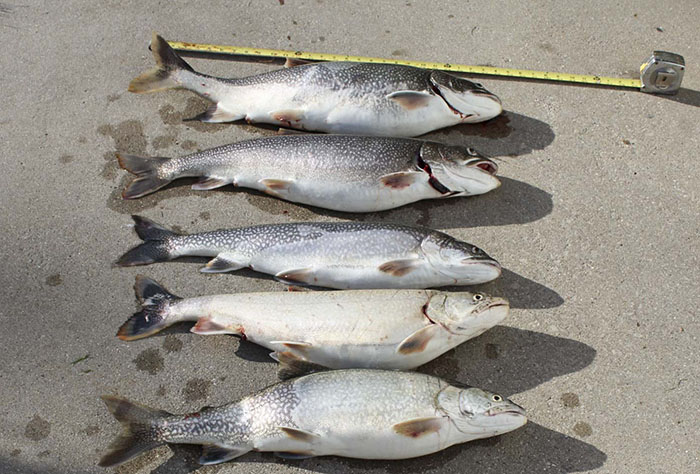
By Jack Nissen
Catch and release was meant to help sustain fish populations. But a four-year study shows it may do the opposite.
Almost half of lake trout caught in Lake Huron and Lake Superior die after they are released, according to the recent study published by the Department of Natural Resource’s Marquette Fisheries Research Station in Northern Michigan.
The trauma of getting caught and the difference in air and water temperatures stress the fish, said Shawn Sitar, the author of the study. “It reduces their survivability.”
By 40 percent to be exact.
The researchers trained anglers to tag trout and record every detail of the catch and release process. Any factor that could indicate a stressful or traumatic experience of the fish provided better information on which fish died.
“The study was rather demanding because they wanted 600 fish,” said Joe Buys, a northern Michigan angler who helped catch the fish. “We recorded things like how the fish were hooked, the temperature of the water and the depth of where the fish were caught.”
To calculate trout mortality, two groups were collected, tagged and then released back into the lakes. One group was caught by commercial fishing nets that didn’t use traditional catch and release methods and one group was caught recreationally by anglers who did use catch and release. Over the span of four years, when tagged fish were re-caught, the anglers reported the catch to Sitar’s team.
The strongest indicator of trout mortality is the water and air temperature when the fish were caught. Because lake trout is a cold water fish, the warmer temperatures is an intense stressor, Sitar said.
The study dispelled some previous assumptions.
Historically, both biologists and anglers assumed that when trout are caught, they die if their stomachs bloat from the change in pressure when they are pulled quickly from deeper to shallower water. However, Sitar found little connection between fish that showed bloating, or barotrauma, and those that died.
“What we found in our study, the number of bloated fish that were tagged and released by our anglers had the same return rate as those that weren’t,” he said. “That tells us the mortality rate being so high is related to the trauma and temperature difference, rather than depth.”
Barotrauma was found in 32 percent of the fish caught for the study in Lake Superior.
The only other study looking at catch and release mortality in the Great Lakes had concluded only 15 percent of fish died. But that study was conducted by attaching fish to shower curtain rings attached to buoys, Sitar said. While a good first attempt, it isn’t the most accurate method for measuring mortality. More research was needed.
Catch and release is intended as a conservation technique. After a fish is caught, a quick measurement is made to see if state regulations require it to be thrown back.
Another technique is to limit how many fish can be caught instead of the size of what’s kept.
States often wrestle with how to control recreational fishing by limiting the size of keepers or through fish quotas, Sitar said. Both the Minnesota and Wisconsin DNR enforce a quota on the number of fish.
Sitar’s study is a good compass for how to regulate fishing, experts say.
“When Sitar’s study came out, we realized we still need to account for how the fish are hooked when they’re caught,” said Brad Ray, a fishery biologist with the Wisconsin DNR. To account for the high mortality rate, the 25-inch minimum for fish was lowered to 15 inches, Ray said.
Most Great Lake states, like Wisconsin and Minnesota, enforce a 15-inch minimum for most fish caught, Sitar said. But because there are so few actually caught it’s not usually a problem.
There aren’t many solutions to solving catch and release mortality, Sitar said. Fishing during colder parts of the season showed less mortality. He also recommended reeling in fish at a slower speed.
People fishing for fun is severely damaging the fish populations in Alaska to the point that we will soon no longer be able to fish for food. Please fish for food. Have fun doing it, but don’t traumatize fish purely for fun.
There is no need to either fish or kill or harm any other animal for your own personal pleasure.
to further refine the technique, yes you are correct. people learn how to catch them but not how to handle and care for them. I’ve always equated landing a fish to a paramedic type rescue.
Truly using a proper technique the fish never really leaves the water and is netted using soft nets and left in the water while suspended with the catch and realease net QUICKLY. Scale loss is a major cause of released fish mortality hence the use of the soft nets (rubber or soft nylon usually black in colour)
I hate to break it to you but the biggest cause of fish mortality is being kept out of the water for too long. a fish wants to be out of the water as long as you want to be underwater. guys lollygag and take too long to get their pictures or get the hook out that’s the cause of mortality.